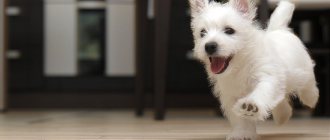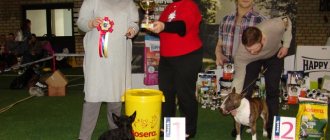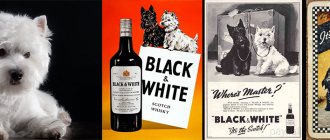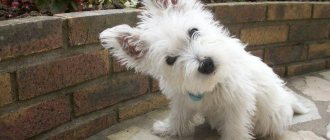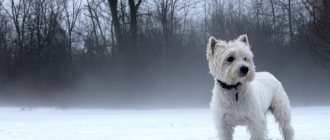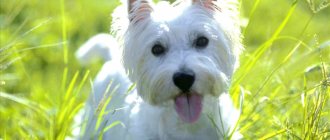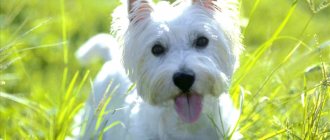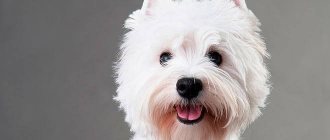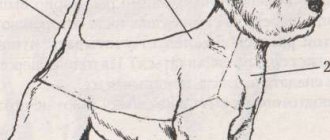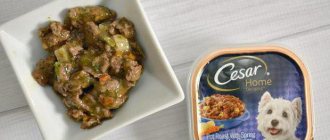West Highland White Terrier
Westies are the most typical representatives of terriers. Like all their relatives, they are smart and a little stubborn. It is believed that of all terriers, the West Highland White Terrier is the most affectionate and at the same time prone to jealousy. However, these small fluffy dogs can be very harsh when it comes to hunting. They are always ready to chase a fox or chipmunk. To prevent these instincts from having a negative impact, the dog needs to be trained and educated.
History of the development of the West Highland White Terrier breed
History of the West Highland White Terrier breed
«Highland White Terrier" - this is how many people translate the name of the breed, which came to us from the west of Scotland. According to history, King James I admired the dogs so much that he bought several terrier dogs, and in addition ordered half a dozen amazing dogs to be sent to the French king as a present.
But also, researchers note the significant contribution to the development of the breed made by Edward Malcolm. It was he who christened this breed with this name. These dogs gained popularity immediately, especially after the exhibition in London.
The goal of breeding the West Highland White Terrier was to create a dog that could hunt small animals. But in addition to hunting instincts, it had to be small in size, dexterous and nimble. They succeeded.
Facial section:
Nose:
Black, rather large, forms a smooth contour with the rest of the muzzle. The nose does not protrude forward.
The nose is large, but slightly protruding, and should be black. However, sometimes in winter the nose becomes lighter due to lack of sunlight.
Muzzle:
The muzzle gradually tapers from the eyes to the end of the muzzle. It does not flatten or fall quickly below the eye line, but forms a well-formed, toned contour.
Jaws/Teeth:
The jaws are powerful and smooth. The width between the canines is sufficient to provide a cunning/playful expression of the muzzle. The teeth are large relative to the size of the dog and have a regular scissor bite, that is, the upper teeth closely overlap the lower teeth and are set at right angles to the jaws.
The West Terrier standard in this part has a large number of interpretations. The English standard does not talk about the number of teeth. Therefore, when judging, the number of premolars should not be taken into account. The jaw should be as wide as possible, U-shaped. In the homeland of the breed, in England, they pay more attention to the correct bite and the number of incisors than to the number of molars and premolars. There should be six incisors on each jaw, a scissor bite. In Europe and Scandinavia, no more than four molars or premolars are allowed to be missing. If more are missing, then the dog has a very slim chance of winning anything.
Eyes:
Wide set, medium size, not round, as dark as possible. Slightly recessed, insightful and intelligent, with a piercing gaze from under heavy eyebrows. Light colored eyes are highly undesirable.
Eyes are assessed based on four features: color, shape, location and expression (this last feature is subjective, but very significant). The eyes are located at the level of the stop. With a correct, wide skull, the eyes are automatically positioned correctly.
Ears:
Small, erect, carried confidently, pointed, set neither too wide nor too narrow. Short and soft (velvety) wool should not be cut. There is no fringe along the top edge. Round, wide, large or thick ears, or ears overgrown with a lot of hair, are highly undesirable.
The ears are also a key point when assessing West. They should be small, not too wide and not too narrow. Imagine a clock dial. 10 hours 10 minutes are ideal ears. 11.05 – these are Scotch’s ears. 09.15 – and this is already a mule! We remind you once again that West’s ears cannot be cropped.
The placement of the ears is related to the shape of the skull. With a narrow skull, even ideal ears will be set close together. And, although the standard does not say this, gray pigmentation on the inner surface of the ear is very welcome!
Neck:
Long enough to allow the head to sit properly, muscular and gradually thickening towards the base, providing a smooth transition into sloping shoulders.
It should be long enough to ensure the necessary proud position of the head. Too thin long (swan) or short wide (bullish) are not welcome. A correctly positioned shoulder blade (at right angles to the humerus) ensures a beautiful neck exit
Frame:
Compact.
Compact. The back is straight. The croup is muscular and wide. The loin is powerful. The chest is deep. The top line appears somewhat flat. The last ribs are long. The distance from the last rib to the hips should be as short as possible, allowing for free movement of the limbs. The skeleton is built like a cone, and when viewed from behind, the front should not be visible.
Back:
Straight.
Small of the back:
Wide and powerful.
Breast:
Wide, ribs well sprung in the upper half, presenting a smooth appearance on the sides. The hind ribs are significantly deepened, the distance from the last rib to the hind legs is as short as possible to ensure free movement of the body.
Tail:
12.5-15 cm long, covered with coarse hair, without fringe, as straight as possible, carried proudly, but not excessively perky and not curled over the back. A long tail is undesirable, but tail docking is not acceptable.
The position of the tail is an indicator of the character and mood of the dog. When all is well, the West holds his tail upright. If the dog is sick, scared or has a weak nervous system, the tail will hang down. The tail length should be 12-15 cm, but consistent with the size of the dog. The length of the tail should not exceed the height of the skull
Limbs:
Forelegs:
The front legs are short and muscular, straight, covered with thick, short, coarse hair.
Shoulders slanted. The shoulder blades should be wide and fit snugly to the chest. The shoulder-scapular joints, due to the oblique position of the shoulder blades, are moved forward, due to which the elbows are directed inward and the front legs can freely move parallel to the axis of the body (like a pendulum). The front legs should be short (but still there should be a gap between the floor and the belly!), muscular, straight and densely covered with short and coarse hair.
Like Cairn Terriers, Westies sometimes have their front paws slightly turned outward, which many take for marking, but breeders explain this by saying that the dog, when digging in a hole, raked the earth to the sides, and not under itself, thereby blocking its exit, and this is influenced by her genetic inheritance.
Shoulders:
They have a backward slope, the shoulder blade is wide and close to the chest. The shoulder joint is displaced forward.
Shoulders slanted. The shoulder blades should be wide and fit snugly to the chest. The shoulder-scapular joints, due to the oblique position of the shoulder blades, are moved forward, due to which the elbows are directed inward and the front legs can freely move parallel to the axis of the body (like a pendulum). The front legs should be short (but still there should be a gap between the floor and the belly!), muscular, straight and densely covered with short and coarse hair.
Elbows:
Shifted back, allowing the front legs to move freely parallel to the axis of the body.
Hind limbs:
Strong, muscular, wide at the top. The legs are short, muscular and sinewy.
The legs should be short and muscular. The thighs are very muscular and not too wide apart. The hock joints are well defined. The hocks are placed under the body so that they are not far from each other if the dog is standing, walking or trotting. The closeness of the hock joints distorts the overall appearance of the dog. Steep or poorly developed metatarsals are undesirable and a fault.
Hips:
Very muscular and not too wide apart. Hocks: Curved and positioned under the body so as to be fairly close together when moving or standing. Straight or weak hocks are highly undesirable.
Paws:
The forefeet are larger than the hindfeet, round, proportional in size, strong, with thick pads, and covered with short, coarse hair. The hind feet are smaller, with thick pads. The lower surface of the pads and all claws are preferably black.
Should be round, with fingers tightly pressed together. The front legs are larger than the hind legs. Nails are preferably black, however, this does not mean that another color is not acceptable.
Gait/movement:
Loose, straight and light all around. The forelimbs move freely forward from the shoulder. The hindquarters move freely, powerfully, close together. The stifles and hocks bend well, and the hocks, pulling under the body, provide a strong forward push. Rigid, inelastic, stilted hindquarters and X-shaped legs are highly undesirable.
A correctly formed girdle of the front and hind legs allows the dog to move freely.
Coat:
Wool: Double layer. The outer layer consists of coarse wool about 5 cm long, without any curls. The undercoat is like fur, short, soft and dense. Loose coats are highly undesirable.
The coat is of two types, the outer coat is hard, about 5 cm long without any curls, and the undercoat, reminiscent of fur, is short, soft and close-lying. However, dogs with very short trimmed hair are often exhibited. What is wrong from the point of view of the standard, however, remains unnoticed by the judges. The fact is that very short hair often hides its shortcomings - excessive softness, waviness, sparse hair. Also, judges often do not pay attention to a serious flaw - soft guard hair. This coat does not turn yellow, it can be shaped well with scissors, and the dog looks like a “toy.”
Wool can change color under the influence of various factors, or even when changing food. Yellowness on the face and paws may be caused by a reaction to saliva. This is not a vice.
Color: White.
SIZE: Height at withers approximately 28 cm.
Approximately 26-28 cm. But a correctly built dog will be given preference even with slight deviations in one direction or another. The weight of an adult dog should be between 7-10 kg.
The standard does not stipulate the weight of the West Highland, but practice shows that a strong Westie male weighs about 8-9 kg, and a female dog in show condition weighs 7-8 kg.
Disadvantages/defects: Any deviation from the above points should be considered as a defect/defect. The seriousness with which a fault should be assessed should be in exact proportion to the degree of its manifestation and the effect on the health and condition of the dog.
Any dog clearly exhibiting physical or behavioral abnormalities must be disqualified.
NB: Males must have two normal testicles fully descended into the scrotum.
Comments on the West Highland White Terrier breed standard
History of the West Highland White Terrier breed from 1907 to 1960
Related Posts
Description of the West Highland White Terrier breed
Description of the West Highland White Terrier
The West Highland White Terrier is a snow-white little miracle, with a slightly shaggy coat, but a reasonable and serious look. Thanks to her small build, she is perfect for the role of a decorative apartment dweller. It reaches 28 cm, with a corresponding weight of 10 kg.
- Head. Representatives of this breed have a wide and slightly convex skull, with prominent brow ridges.
- Jaws and bite. Although the West Highland White Terrier is a fairly miniature dog, it has powerful jaws. If we talk about the bite, it is of a scissor type.
- Eyes. Wide almond-shaped and set deep. They have a dark iris color.
- Nose. West Highland White Terriers have a large nose and a black nose.
- Ears. Pointed small ears are not too wide and stand straight. The outer side of the ear is covered with velvety fur, which is never cut.
- Frame. The body of representatives of this breed is compact, with a straight back and a strong lumbar region.
- Tail. The Westie has a straight tail up to 15 cm long, which it carries almost vertically.
- Wool. The West Highland White Terrier's coat consists of a dense furry undercoat and coarse outer coat, the length of which can reach 5 cm.
- Color. The West Highland White Terrier is one of those few breeds, modern representatives of which exist in one single color - white. An important point: the color of the wool is extremely unstable and very dependent on external factors, so among animals there are often individuals whose “fur coats” have a yellowish tint.
West Terrier head:
The distance from the back of the head to the eyes is slightly greater than the length of the muzzle. The head is covered with dense hair, set at a right angle or less to the axis of the neck. The dog should not carry its head in an extended position.
Cranial region: The skull is slightly convex; when grasped with fingers across the forehead, it forms a smooth arc. Slightly tapering from ears to eyes. Transition from skull to muzzle: Pronounced; formed by a heavy bony protrusion slightly overhanging directly above the eyes, and a small depression between the eyes.
A comment:
To appreciate West's head, one must abstract from the fur, which interferes with perception. A hairstyle can be perfect or bad, but it is still just a hairstyle. The main thing is under it! The skull should be wide, with prominent brow ridges that protect the eyes and a pronounced stop. If we press our finger to the front of the head, we feel that the skull has a smooth outline. At eye and ear level, the head should be only slightly cone-shaped. The distance from the occipital protuberance to the eyes should be slightly greater than the length of the muzzle. The transition from the forehead to the muzzle, formed by the protruding brow ridges, is clearly defined. The front of the head should not be sunken or droop sharply below the eyes, but should be well filled. The jaws should be strong and straight. The head should be covered with thick hair and held at a straight or slightly greater angle to the axis of the neck. Under no circumstances should it be an extension of the neck.
Personality of West Highland White Terriers
Character of the West Highland White Terrier
Representatives of this breed have an inquisitive mind. These are sociable, affectionate dogs that love to always be close to people. But it will be very difficult for them to build friendly relationships with other animals. If you already have a West Highland White Terrier and are planning to purchase a new pet, it is worth considering this nuance. Moreover, they are jealous of their owners.
Like all terriers, West Highland White Terriers love to bark and dig, and sometimes both at the same time, demonstrating their independence and tenacity. And also a little stubbornness.
With such pets you need to frequently play active games and take time for long walks, as they have a very large supply of energy.
Westies have good manners, which is why they are considered intellectuals. Although they are more of a calm dog, they, like everyone else, love to have fun and play.
West Highland White Terriers can get along well with older children. But if there is a small child in your home, then keep in mind that representatives of this breed will not tolerate rudeness from children.
Character and training
The Westie is a typical terrier, which means that it will be easy and difficult at the same time. Easy - because he is smart, quick-witted and remembers everything well. It can be difficult at first due to the dog’s independence and excessive mobility.
Westies, deprived of hunting leisure, are forced to constantly somehow realize their potential of motor activity, ingenuity and combativeness. The best way to channel energy into a “peaceful direction” is, of course, play.
The education of a puppy and a junior is built on the gaming platform. Given the restlessness of young terriers, lessons should be preceded by good walks. The best results will be achieved if you find the right balance of game elements, rigor and rewards.
Terriers can and should be punished, otherwise they will quickly imagine themselves to be the boss in the house. As for rewards, mutual (!) joy and pleasure works best. Show the Westie that you are happy when he successfully completed a task, and he will try to do it again and again.
Terriers do not suffer from gluttony, and food is not the main thing for them. Gustatory reward is recommended only at the very beginning of the training process to practice basic commands. It is also worth using treats to train him to be trimmed on the table.
Westies enjoy any activity provided they are in good company - people, other dogs and even cats. If the terrier is lucky and has a successful owner, you can practice agility, pitch and go, participate in competitions with a puller, and Frisbee. Sports training does not harm a show career at all.
It is too cruel to limit the Westie within the framework of exhibition handling alone. However, it is recommended to accustom him to examinations on the table and movement in the ring already in puppyhood.
In general, terriers can be loaded with a variety of training without fear of a nervous breakdown. Westies think quickly and easily switch to any program of action. This is the case when decorativeness did not turn the dog into a weak-willed toy.
Keeping and caring for the West Highland White Terrier
Keeping a West Highland White Terrier
The breed needs special care and attention from early childhood. The West Highland White Terrier needs frequent walks to keep its physique properly shaped. The best option for this breed would be to live in a country house with a large plot, but it would also be quite comfortable in a city apartment.
The main difficulties you will encounter are related to caring for your pet's fur. The dog must be thoroughly combed at least twice a week. It is especially worth paying attention to the hair in the armpits and on the stomach, as it quickly mats there and forms tangles.
Toilet training West Highland White Terrier
Toilet train a West Highland White Terrier
As soon as the puppy arrives in your home, he needs to be toilet trained. But if due to age he cannot go outside yet (he does not have the necessary vaccinations), you can teach the puppy to go to the toilet using a special diaper. How to do it?
- Lay down newspaper, absorbent diapers or a rubber mat
- It is best to use an oilcloth tablecloth with a soft cover from the inside out, turning it over with the oilcloth facing down towards the floor. This way, the puppy’s paws will not slip and it’s easy to rinse such material.
- Place it in a designated place and train the puppy to use the “toilet”.
- Take the puppy to the “toilet” after eating and after sleep and praise each time for a successful result.
- As soon as your puppy can go out for walks, start teaching him to relieve himself outside. To do this, take him outside after sleep and after each meal for 5-10 minutes. The more often you carry your puppy, the faster he will understand what is required of him.
Buying the necessary accessories for West Highland White Terriers:
- Collar, leash.
- Feeders - for food and water.
- Special scissors for trimming claws.
- Comb. Pukhoderka.
- Toilet mat, diapers
- Toys.
- Dress according to the season.
How to properly wash West Highland White Terriers
It is recommended to bathe the dog once every 30-40 days, using a special shampoo that is suitable for long-haired breeds. The choice of shampoo must be approached especially carefully, since Westie skin is prone to allergies and dermatitis.
Recommendations that may help you:
- If there is a draft in the house, it must be eliminated. Wet dogs get cold easily.
- Liquid detergents are diluted with water, then the wool is lathered with this solution. This way the shampoo cleanses and foams better.
- You need to apply the product, starting from dirty areas to cleaner ones: paws → tummy → back → tail → head.
- You can’t dry a wet dog, just pat it dry with a towel.
- When using a hairdryer for drying, you need to select a low-intensity mode.
- Wavy fur can be corrected by blow-drying it.
But the most important thing is to remember that every bath is a lot of stress for your pet. Therefore, try to talk to him and calm him down throughout the procedure.
Walking a West Highland White Terrier
Walking a West Highland White Terrier
The most suitable walking system for Westies is two walks every day for 40-60 minutes each. This time will be enough for your pet to spend all its accumulated energy and get a good workout. A large amount of stress is harmful for this breed, as dysplasia may appear.
Try to accustom your dog to a leash and collar from childhood. They can easily run after a cat or some kind of rodent, which is why a leash is necessary.
Nutrition of the West Highland White Terrier
Feeding the West Highland White Terrier
Diet for puppies
Until they are three months old, puppies are fed 3 times a day, after which they need to switch to two meals a day. It is strictly forbidden to feed your pet from the table. Firstly, you must wean the animal from begging. Secondly, it should be remembered that what is beneficial for a person may be harmful for a dog. The main growth process of a puppy occurs for the first six months of life.
The diet should contain a large amount of proteins and fats, but there should be little starch so that the pet does not suffer from diarrhea. It is also necessary to add mineral and vitamin supplements, they will have a beneficial effect on the proper formation of the skeleton
Diet for an adult dog
Many people mistakenly believe that an adult dog can be fed in the same way as a puppy, but this is a mistaken opinion. Puppy food should be filled with a lot of protein, fat and calcium - this is not suitable for an adult dog. The diet should not contain more than 16% fat. The feed must contain sufficient fiber to prevent excessive fermentation.
Where did the West Highland White Terrier come from?
Unfortunately, no one can say with certainty the exact historical period of the appearance of this breed. What is known is that the first serious mentions of it date back to the Middle Ages. This breed was developed in Scotland; the most likely ancestor of the white terrier is the Scotch terrier.
Initially, these were working hunting dogs, whose prey was small rodents and burrowing animals. Despite its miniature size, the West Highland White Terrier is distinguished not only by its energy and courage, but also by its strength and endurance. The hunt went like this: the dog had to discover the animal’s hole and drive it out of there. In some cases, white terriers retrieved already dead prey from their shelters, which they had acquired in a difficult battle underground. In the household, these cute creatures helped their owners get rid of rodents.
From a distance, the noticeable white color of the terrier was not invented by chance. There are no wild animals in nature with such fur, so a hunter is unlikely to confuse it with, say, a fox or a badger.
At the beginning of the 20th century, the white terrier received an official name and breed standard that remains unchanged to this day. Only in the modern world it is rarely used as an assistant in hunting. Over time, the West has become a sought-after and indispensable friend to many families around the world.
West Highland White Terrier Health
West Highland White Terrier Health
Representatives of this breed have good health with a life expectancy of up to 15 years. But even though West Highland White Terriers are not considered to have health problems, they have a list of diseases to which they are most often exposed:
- Pulmonary fibrosis
- Yeast dermatitis
- Atopy
- Food allergies
- Cutaneous histiocytoma
- Cataract
- Keratoconjunctivitis
- Diabetes
- Hip dysplasia
- Congenital deafness
- White dog meningoencephalitis
- Aseptic necrosis of the femoral head
- Craniomandibular osteopathy
- Cardiomyopathy
Pros and cons of the breed
The number of points is approximately equal. What seems like a disadvantage to someone does not frighten people with other life attitudes and circumstances at all.
Pros:
- Small size.
- Charming and attractive.
- Cheerful character.
- Successfully trained.
- Has no smell.
- Does not shed hair (subject to trimming).
West Highland White Terrier breeding
Mating of West Highland White Terriers
The West Highland White Terrier can be classified as a rare species of animal, and therefore mating can be breeding and official. Puberty in puppies occurs at 8-10 months. But to ensure that animals do not develop any pathologies, they need to be bred only after 20 months. The recommended time is 13-15 days from the start of the girl’s estrus.
First of all, the dogs need to be introduced to each other. They are walked together the day before mating. At the appointed time, the female is brought to the male’s territory, where the act should take place. It will last no more than 20 minutes, but pets can stay in the castle for a long time.
Character
The West Highland White Terrier dog is quite calm, but at the same time mischievous and playful with its owner. With all their intelligence, set of good manners and self-control, pets are ready to fight for loved ones and protect them from any misfortune, engaging in serious fights with even large animals. Terriers fight to the bitter end.
Small, but very brave, they are highly trainable and learn everything very easily and quickly. They require a lot of attention and education, and are rarely stubborn.
Energetic and active, have a good sense of smell. They sense danger and do not leave the arrival of guests unnoticed. They love to be the center of attention, they are sociable, although they tend to be jealous of their owner’s other pets. They love children and treat them with care and caution. They cannot stand being ignored and cannot tolerate being treated rudely.
Births of the West Highland White Terrier
Giving birth to a West Highland White Terrier
- Discuss with your veterinarian the possibility of him coming if necessary, especially if the dog is giving birth for the first time.
- Set up a special place where the female will feel comfortable staying and giving birth.
- A special box must be prepared for newborn puppies.
- The room should have normal heating for mother and babies (optimal temperature ranges from +20˚ to +28˚).
Remember that small breeds like West Highland White Terriers have a little more difficulty giving birth than larger dogs. Therefore, it is very important to prepare well.
Training and education of the West Highland White Terrier
Training a West Highland White Terrier
As soon as the puppy appears in your home, you need to build the right line in the relationship, then the dog will trust you and consider you a leader. If you don't train your pet, it will be very difficult to manage. He will chase other animals, pick up some food or objects on the street, dig up the owner's beds, and so on. If you interest the animal, then no problems with education and training will arise. You can reward your dog for good behavior with treats and kind words. As punishment, you can use a stern voice, or ignore the dog without responding to its calls to play. You should not beat an animal - it is not only offensive, but also separates the message from the owner and introduces distrust in the person.
When learning commands, preference should also be given to rewarding correct execution by giving a treat.
Closer to 4 months, we begin active socialization of the puppy. We no longer walk in deserted places, we gradually get acquainted with noisy streets, and get used to communicating with unfamiliar people and animals.
By the age of 5 months, we teach the West Highland White Terrier puppy the following skills:
- Slowly moving next to the owner with and without a leash
- Command "come to me"
- Indifference to food lying on the street
- “sit”, “lie down”, “stand” on command by voice and gestures
Training and education of a little hunter
The White Terrier dog is an easygoing breed and is easy to train and train . She manages to remember the most difficult tricks. She can be stubborn sometimes, but that goes away quickly.
Training can be successful even for a novice dog breeder. West Highland White puppies will better learn behavioral norms if they are trained while getting used to the house and its owner. The main set of commands can be given while playing with the animal. A ball flying towards a dog should be accompanied by the words: “Come to me!”, “Fetch!”.
For proper training, you need to prepare the appropriate equipment:
- soft collar or harness;
- leash;
- an attractive toy (a bone or a ball);
- treats to reward success.
When the dog is 3 months old, you need to begin training the West Highland White. He is given to trainers for courses where they are taught to understand the basic commands: “Sit!” “Ugh!”, “Nearby!”, “Place”!”, “Stand!”, “Lie down!”
It is unacceptable to punish a dog for disobedience. It's better to play with it and then get back to work. Even with some stubbornness, the West Highland Terrier is an easy breed to train.
Special classes are held to develop hunting skills. They are trained on hunting, using the experience of adult animals.
How to choose a West Highland White Terrier puppy
How to choose a West Highland White Terrier puppy
- Choose reliable, proven nurseries registered by the RKF. Usually all matings in them are planned.
- The gender of the West Highland White Terrier has virtually no effect on its temperament type and intellectual abilities.
- Assess the level of hygiene and living conditions of the puppies in the kennel. It’s great if the kids don’t sit in dirty cages, but move freely around the territory allotted to them.
- Touch the belly of the puppy you like. If additional swelling is felt in the navel area or there is bulging of the peritoneum, there is a possibility that the baby will be diagnosed with a hernia in the future.
How to name a dog, popular nicknames
The most popular West Highland nicknames are:
- For boys: Abo, Abur, Aston, Barry, Best, Willie, Windy, Guy, Gray, Grem, Dani, Jaco, Idefix (as from the movie “Asterix and Obelix: Mission Cleopatra”), Candy, Krosh, Loy, Larry , Nur. Nemo, Oji, Oras, Punch, Push, Rumbik, Stem, Tim, Ursik, Frank, Frel, Chessie, Chukki, Andy, Eron, Yuji, Yushan, Yarosh, Janson, Iago.
- For girls: Ada, Asta, Bina, Bonya, Vesta, Gabi, Jackie, Jeri, Ketty, Carrie, Leda, Miki, Nolly, Oda, Oksa, Peggy, Ricky, Sendy, Tora, Terry, Fanny, Frieza, Frezi, Holly , Tserry, Cesi, Shammi, Shimmy, Etna, Eteri, Esta, Yuda, Yusi, Yaza.
Interesting facts about the West Highland White Terrier breed
Facts about the West Highland White Terrier breed
- West Highland White Terriers lived in families at different times: Roman Abramovich,
- Michael Schumacher,
- Dieter Bohlen,
- Stanislav Govorukhin,
- Petra Marchenko,
- Leonid Yarmolnik,
- Paris Hilton,
- Oleg Popov,
- Alexandra Adabashyan,
- Jennifer Aniston,
- Scarlett Johansson
- Alfred Hitchcock
- Frank Sinatra
- Rob Schneider
- Inna Churikova.
Activities of the National Breed Club (NKB)
Such an organization began to exist in the Russian Federation back in 1999. At that time, the NKP included 2 types of dogs: Cairn Terriers and West Terriers. And already in 2004, a separate special breed club appeared.
The West Highland White Terrier National Breeding Club organizes annual events for animals and their owners; dog shows are held in various cities of Russia. Only owners of real West Highlands can get into them; pets must fit the standard “West Highland White Terrier breed”, have all kinds of documentary evidence of this and a good pedigree.
NKP also sells white terrier puppies. Many articles posted on the official website and seminars conducted by the club help the owners of these beautiful creatures answer many of the questions they have.
Comparative table of positive and negative traits of the West Highland White Terrier
| Positive traits | Minuses |
| the dog will be comfortable living even in an apartment | It is necessary to carefully monitor the condition of the coat |
| it does not cause allergies in residents, since its fur does not shed; | Males are stubborn, so they need a special approach during training. |
| the learning process will not cause difficulties | the breed is wayward, there must be strict upbringing; |
| Highlanders are devoted to their family | Because the wool is white, it often gets dirty |
| easily adapts to the city. There is no trouble on the street. | loud frequent barking |
| considered the most affectionate of all terriers |
